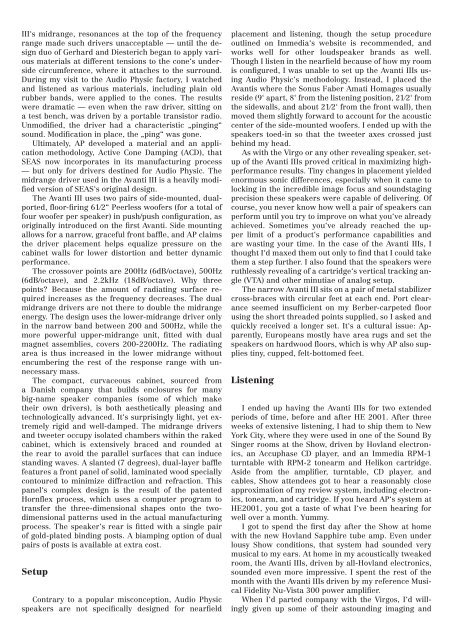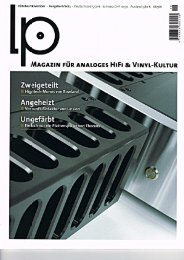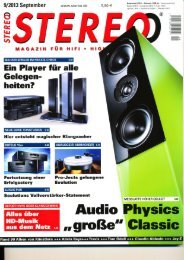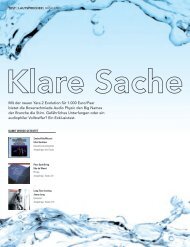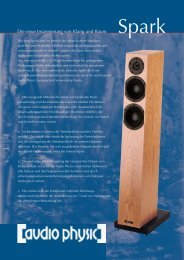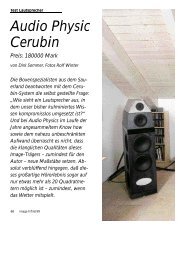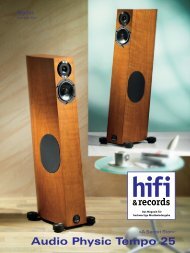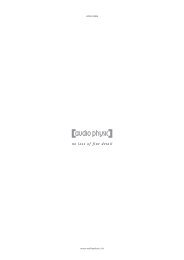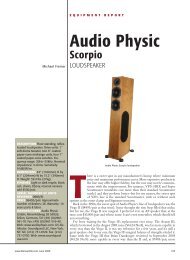Avanti III loudspeaker - Audio Physic
Avanti III loudspeaker - Audio Physic
Avanti III loudspeaker - Audio Physic
Create successful ePaper yourself
Turn your PDF publications into a flip-book with our unique Google optimized e-Paper software.
<strong>III</strong>‘s midrange, resonances at the top of the frequency<br />
range made such drivers unacceptable — until the design<br />
duo of Gerhard and Diesterich began to apply various<br />
materials at different tensions to the cone‘s underside<br />
circumference, where it attaches to the surround.<br />
During my visit to the <strong>Audio</strong> <strong>Physic</strong> factory, I watched<br />
and listened as various materials, including plain old<br />
rubber bands, were applied to the cones. The results<br />
were dramatic — even when the raw driver, sitting on<br />
a test bench, was driven by a portable transistor radio.<br />
Unmodified, the driver had a characteristic „pinging“<br />
sound. Modification in place, the „ping“ was gone.<br />
Ultimately, AP developed a material and an application<br />
methodology, Active Cone Damping (ACD), that<br />
SEAS now incorporates in its manufacturing process<br />
— but only for drivers destined for <strong>Audio</strong> <strong>Physic</strong>. The<br />
midrange driver used in the <strong>Avanti</strong> <strong>III</strong> is a heavily modified<br />
version of SEAS‘s original design.<br />
The <strong>Avanti</strong> <strong>III</strong> uses two pairs of side-mounted, dualported,<br />
floor-firing 61⁄2“ Peerless woofers (for a total of<br />
four woofer per speaker) in push/push configuration, as<br />
originally introduced on the first <strong>Avanti</strong>. Side mounting<br />
allows for a narrow, graceful front baffle, and AP claims<br />
the driver placement helps equalize pressure on the<br />
cabinet walls for lower distortion and better dynamic<br />
performance.<br />
The crossover points are 200Hz (6dB/octave), 500Hz<br />
(6dB/octave), and 2.2kHz (18dB/octave). Why three<br />
points? Because the amount of radiating surface required<br />
increases as the frequency decreases. The dual<br />
midrange drivers are not there to double the midrange<br />
energy. The design uses the lower-midrange driver only<br />
in the narrow band between 200 and 500Hz, while the<br />
more powerful upper-midrange unit, fitted with dual<br />
magnet assemblies, covers 200-2200Hz. The radiating<br />
area is thus increased in the lower midrange without<br />
encumbering the rest of the response range with unnecessary<br />
mass.<br />
The compact, curvaceous cabinet, sourced from<br />
a Danish company that builds enclosures for many<br />
big-name speaker companies (some of which make<br />
their own drivers), is both aesthetically pleasing and<br />
technologically advanced. It‘s surprisingly light, yet extremely<br />
rigid and well-damped. The midrange drivers<br />
and tweeter occupy isolated chambers within the raked<br />
cabinet, which is extensively braced and rounded at<br />
the rear to avoid the parallel surfaces that can induce<br />
standing waves. A slanted (7 degrees), dual-layer baffle<br />
features a front panel of solid, laminated wood specially<br />
contoured to minimize diffraction and refraction. This<br />
panel‘s complex design is the result of the patented<br />
Hornflex process, which uses a computer program to<br />
transfer the three-dimensional shapes onto the twodimensional<br />
patterns used in the actual manufacturing<br />
process. The speaker‘s rear is fitted with a single pair<br />
of gold-plated binding posts. A biamping option of dual<br />
pairs of posts is available at extra cost.<br />
Setup<br />
Contrary to a popular misconception, <strong>Audio</strong> <strong>Physic</strong><br />
speakers are not specifically designed for nearfield<br />
placement and listening, though the setup procedure<br />
outlined on Immedia‘s website is recommended, and<br />
works well for other <strong>loudspeaker</strong> brands as well.<br />
Though I listen in the nearfield because of how my room<br />
is configured, I was unable to set up the <strong>Avanti</strong> <strong>III</strong>s using<br />
<strong>Audio</strong> <strong>Physic</strong>‘s methodology. Instead, I placed the<br />
<strong>Avanti</strong>s where the Sonus Faber Amati Homages usually<br />
reside (9‘ apart, 8‘ from the listening position, 21⁄2‘ from<br />
the sidewalls, and about 21⁄2‘ from the front wall), then<br />
moved them slightly forward to account for the acoustic<br />
center of the side-mounted woofers. I ended up with the<br />
speakers toed-in so that the tweeter axes crossed just<br />
behind my head.<br />
As with the Virgo or any other revealing speaker, setup<br />
of the <strong>Avanti</strong> <strong>III</strong>s proved critical in maximizing highperformance<br />
results. Tiny changes in placement yielded<br />
enormous sonic differences, especially when it came to<br />
locking in the incredible image focus and soundstaging<br />
precision these speakers were capable of delivering. Of<br />
course, you never know how well a pair of speakers can<br />
perform until you try to improve on what you‘ve already<br />
achieved. Sometimes you‘ve already reached the upper<br />
limit of a product‘s performance capabilities and<br />
are wasting your time. In the case of the <strong>Avanti</strong> <strong>III</strong>s, I<br />
thought I‘d maxed them out only to find that I could take<br />
them a step further. I also found that the speakers were<br />
ruthlessly revealing of a cartridge‘s vertical tracking angle<br />
(VTA) and other minutiae of analog setup.<br />
The narrow <strong>Avanti</strong> <strong>III</strong> sits on a pair of metal stabilizer<br />
cross-braces with circular feet at each end. Port clearance<br />
seemed insufficient on my Berber-carpeted floor<br />
using the short threaded points supplied, so I asked and<br />
quickly received a longer set. It‘s a cultural issue: Apparently,<br />
Europeans mostly have area rugs and set the<br />
speakers on hardwood floors, which is why AP also supplies<br />
tiny, cupped, felt-bottomed feet.<br />
Listening<br />
I ended up having the <strong>Avanti</strong> <strong>III</strong>s for two extended<br />
periods of time, before and after HE 2001. After three<br />
weeks of extensive listening, I had to ship them to New<br />
York City, where they were used in one of the Sound By<br />
Singer rooms at the Show, driven by Hovland electronics,<br />
an Accuphase CD player, and an Immedia RPM-1<br />
turntable with RPM-2 tonearm and Helikon cartridge.<br />
Aside from the amplifier, turntable, CD player, and<br />
cables, Show attendees got to hear a reasonably close<br />
approximation of my review system, including electronics,<br />
tonearm, and cartridge. If you heard AP‘s system at<br />
HE2001, you got a taste of what I‘ve been hearing for<br />
well over a month. Yummy.<br />
I got to spend the first day after the Show at home<br />
with the new Hovland Sapphire tube amp. Even under<br />
lousy Show conditions, that system had sounded very<br />
musical to my ears. At home in my acoustically tweaked<br />
room, the <strong>Avanti</strong> <strong>III</strong>s, driven by all-Hovland electronics,<br />
sounded even more impressive. I spent the rest of the<br />
month with the <strong>Avanti</strong> <strong>III</strong>s driven by my reference Musical<br />
Fidelity Nu-Vista 300 power amplifier.<br />
When I‘d parted company with the Virgos, I‘d willingly<br />
given up some of their astounding imaging and


